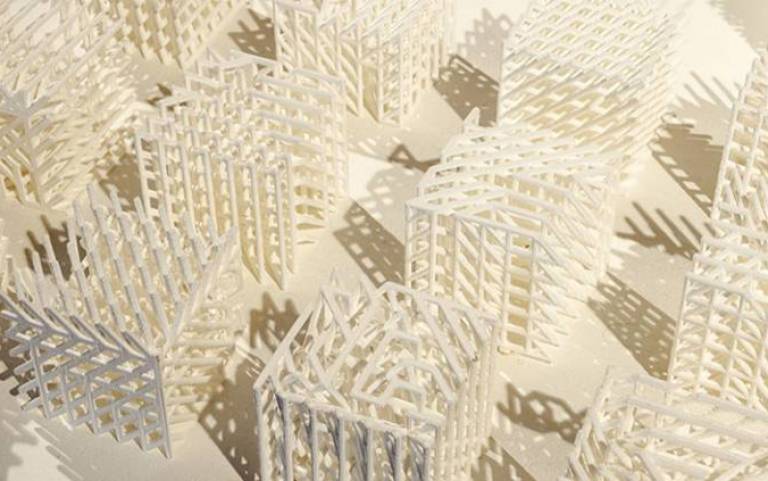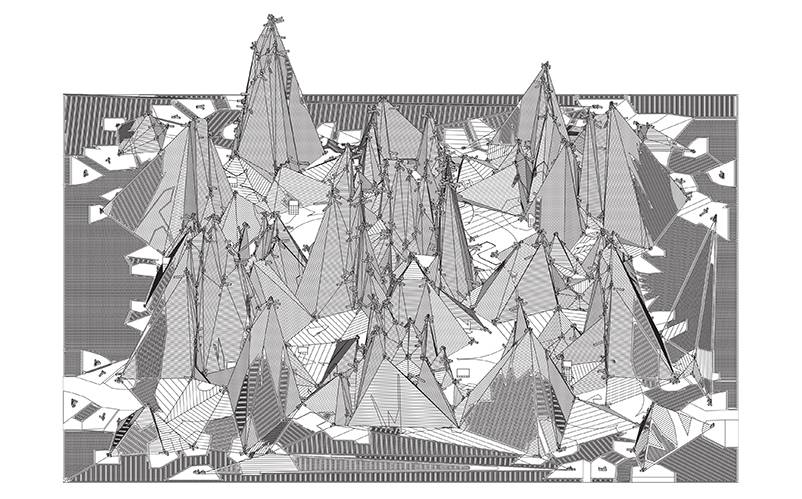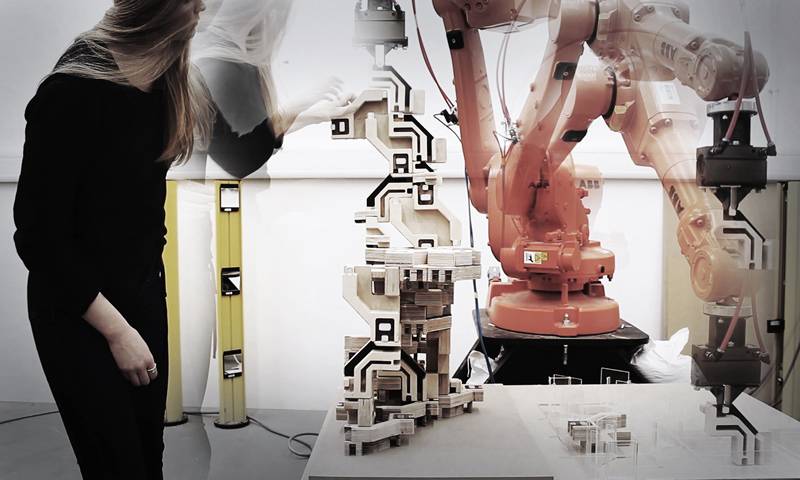Prospectives Lecture Series Spring 2020
15 January 2020–12 February 2020, 1:00 pm–2:00 pm

A B-Pro History and Theory lecture series, highly recommended for Architectural Design, Urban Design and Architectural Computation students as well as interested professionals.
Event Information
Open to
- All
Organiser
-
The Bartlett School of Architecture020 3108 7337
Location
-
1.0222 Gordon StreetLondonWC1H 0QBUnited Kingdom
About
The B-Pro Prospectives History and Theory Lecture Series offers a platform for presentation, discussion and theoretical reflection upon the links between digital thought, architecture, and urban design. This year's series of talks emphasise the key role computation plays within complex design synthesis and their cultural implications.
This series encourages and inspires the current student body and interested professionals, by creating conversations about topics addressing academia, practice and beyond as well as overall disciplinary concerns and frontiers.
B-Pro, or Bartlett Prospective, groups together five of the school's graduate programmes with a unique philosophy and shared approach to the future of design, architecture and the urban environment. The B-Pro Prospectives lecture series is organised by Roberto Bottazzi and Emmanouil Zaroukas.
Schedule
- 15 January | William Latham
Evolutionary Drawings to Virtual Reality
William discusses the history of his work, from his rule based “Constructivist style” drawings, to his FormSynth Evolutionary drawings and his work developing the FormGrow grammar and Mutator code with Stephen Todd at IBM in Winchester. He also explores his work in Rave Music, Cyberculture and computer games.
Biography
William Latham is Director and Co-Founder of SoftV Ltd (developing therapy Apps for the NHS) and a Director London Geometry Ltd. He is also an Associate Professor at the Institute of Neurology, UCL.
William is well known for his pioneering Organic Art created in the late eighties and early nineties whilst a Research Fellow at IBM in Winchester. He has also worked in Rave Music and computer games development for ten years, where he created console and PC games published by Vivendi Universal, Microsoft and Warner Bros. In 2007 he became a Professor in Computing at Goldsmiths University of London with research projects in modelling and visualising DNA / RNA Structures and Virus structures.
- 22 January | Ciro Najle
The Generic Sublime
Skyscrapers, high-rise housing, conference centers and entertainment venues are all part of the Generic Sublime. In this lecture, Ciro Najle investigates how the concept of the generic holds the potential to turn into the singular, the irreducible and the extraordinary. He explores how the Generic Sublime uses absorption and envelopment to initiate a vast megalomaniacal leap, whereby soft and hard infrastructures, artificial ecologies and manifolds of anti-urban conditions can interact in the synthetic three-dimensional field of the XXL building.
Biography
Architect Ciro Najle is Dean and Professor of the Escuela de Arquitectura y Estudios Urbanos at the Universidad Torcuato Di Tella in Buenos Aires. He was also Director of the Landscape Urbanism graduate programme at the Architectural Association, and has been a Visiting Professor at Harvard University, Cornell University, Columbia University, the Berlage Institute, the Universidad Federico Santa María, and the Universidad de Buenos Aires.
Ciro is also Director of the General Design Bureau in Buenos Aires, and his work has been widely published in international media. His publications include: The Generic Sublime (Actar / Harvard, 2016), Suprarural (Actar, 2017), with Lluís Ortega, and Landscape Urbanism, A Manual for the Machinic Landscape (AA, 2002), with Mohsen Mostafavi. He is also editor of Superdigitalismos (CPAU, 2019), and has written for Quaderns, Space, Oris, Praxis, Harvard Design Magazine and the interview series Out of Time (Plot, 2012-present).
Image: The Generic Sublime, © Ciro Najle.
- 29 January | Poltak Pandjaitan
Crystalgebra: Architectonic Articulations in Crystal Space
Poltak Pandjaitan questions how we can implement and translate spatial concepts in crystal topologies, in which the crystal space provides the setup for the architectonic articulations. He provides an overview of how the crystals can be embedded in architecture and explores how purposive abstraction and translation of spatialities, combined with the notion of crystals as an algebraic code like structure, can be used to scrutinise the meaning of space.
Biography
Poltak Pandjaitan is an architect and researcher based in Vienna. He received his his PhD from ETH, Zurich in 2018, during which he participated as a project architect for the Incidental Space installation at the 15th La Biennale di Architettura, Venezia 2016. Poltak also worked as an architect at Gramazio Kohler Architects in 2014 and received the TISCHE Scholarship from the Federal Chancellery of the Republic of Austria for Arts and Culture in the same year.
Poltak studied Architecture at the University of Technology Vienna in 2011 and is currently working as an architect at Coop-Himmelb(l)au.
- 05 February | Patricia Reed
Planetary Localisation: Respatialising the Site
Patricia Reed explores the role of architecture within the idea of ‘planetarity’ as an epistemic proposition. She suggests that in order to transform configurations of co-existence, new models of spatiality must be constructed to situate this co-existence. She investigates how planetarity conceptions of human-centred space can be put into practice as new frames of reference that undergird a different sensorium of spatial intuition.
Biography
Patricia Reed is an artist, writer and designer based in Berlin. Her work has been included in many publications, such as The New Normal (MIT Press), Construction Site for Possible Worlds (Urbanomic), Glass Bead Journal (Glass Bead), Post-Memes (Punctum Books), and Xeno-Architecture (Sternberg). Patricia's research concerns configurations of co-existence within and for complex techno-social-geo conditions.
Patricia is also part of the Laboria Cuboniks working group whose Xenofeminist Manifesto was republished by Verso Books in 2018, with further book-length translations in Korean, French, and Greek.
- 12 February | Inigo Wilkins
Computational Architectures: Prediction, Compression, and Construction
Inigo Wilkins, founder of journal and research platform Glass Bead, explores how thought can be understood as a predictive processing machine, which uses probability to track the dynamics of its architectural environment. He discusses how a data-driven parametric responsiveness fails to recognise the full complexity of the computational architecture of thought, which is multi-modal and therefore fully political and historical. He also explores how architecture may realise not just the constructive facilitation of alternative modes of living, but also the complete transformation of the conditions of possibility of living.
Biography
Inigo Wilkins is a founder of the journal and research platform Glass Bead. He completed his Master's in Sonic Culture at the University of East London, and his PhD in Cultural Studies at Goldsmiths University. The title of his thesis was Irreversible Noise, which he is now working on for a forthcoming publication by Urbanomic.
Inigo's publications include, ‘Interfacey McInterface Face’ Litteraria Pragensia 2017; ‘Destructive Destruction: An Ecological Study of High Frequency Trading’ first published in Mute magazine, 2013; and ‘Catalyzing Dissent’ published in Mute magazine, December 2012.
Access
If you have any access requirements please let us know by sending us an email or calling 020 3108 7337.
 Close
Close


